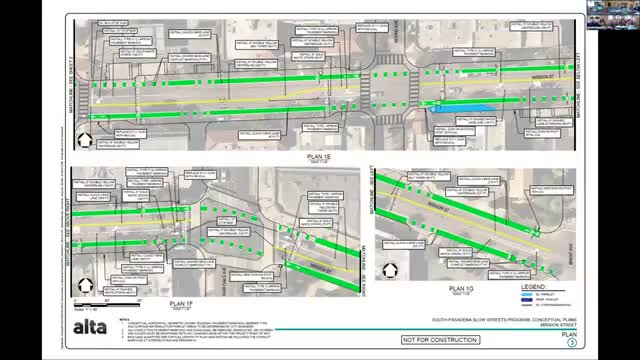Road Diet Plan implemented along Mission Street to reduce traffic delays
May 25, 2025 | South Pasadena City, Los Angeles County, California
This article was created by AI summarizing key points discussed. AI makes mistakes, so for full details and context, please refer to the video of the full meeting. Please report any errors so we can fix them. Report an error »

In a recent meeting of the South Pasadena Public Works Infrastructure Commission, city officials discussed significant changes to local road configurations aimed at improving traffic flow and safety. The meeting, held on May 20, 2025, focused on the proposed "road diet" plan, which seeks to reduce lane numbers on key streets while enhancing bicycle and pedestrian access.
The primary topic of discussion was the redesign of Mission Street and its intersections, particularly between Fremont Avenue and Fair Oaks Avenue. The proposed changes include narrowing lanes to create space for bike lanes, which officials believe will encourage more sustainable transportation options. The commission emphasized the importance of engaging with local businesses during the design process to ensure that their needs are considered.
Commission members reviewed traffic studies that assessed current conditions and projected the impact of the proposed changes. They noted that while some intersections currently operate at a satisfactory level, the anticipated modifications could lead to slight increases in vehicle delays. For instance, the analysis indicated that implementing the road diet could result in a minor drop in the level of service at certain intersections, with delays of up to 15 seconds during peak hours.
The discussion also highlighted the need for careful consideration of traffic patterns, particularly at critical junctions where lane reductions could create confusion for drivers. Officials acknowledged that the transition from a four-lane to a two-lane configuration might require additional signage and public education to mitigate potential traffic disruptions.
As the commission moves forward with the design phase, they plan to conduct further outreach to gather community feedback and refine their proposals. The outcome of these discussions will play a crucial role in shaping South Pasadena's transportation landscape, balancing the needs of motorists with the growing demand for safer, more accessible streets for all users. The commission's next steps will involve finalizing the design and preparing for implementation, with the goal of enhancing both traffic efficiency and community safety.
The primary topic of discussion was the redesign of Mission Street and its intersections, particularly between Fremont Avenue and Fair Oaks Avenue. The proposed changes include narrowing lanes to create space for bike lanes, which officials believe will encourage more sustainable transportation options. The commission emphasized the importance of engaging with local businesses during the design process to ensure that their needs are considered.
Commission members reviewed traffic studies that assessed current conditions and projected the impact of the proposed changes. They noted that while some intersections currently operate at a satisfactory level, the anticipated modifications could lead to slight increases in vehicle delays. For instance, the analysis indicated that implementing the road diet could result in a minor drop in the level of service at certain intersections, with delays of up to 15 seconds during peak hours.
The discussion also highlighted the need for careful consideration of traffic patterns, particularly at critical junctions where lane reductions could create confusion for drivers. Officials acknowledged that the transition from a four-lane to a two-lane configuration might require additional signage and public education to mitigate potential traffic disruptions.
As the commission moves forward with the design phase, they plan to conduct further outreach to gather community feedback and refine their proposals. The outcome of these discussions will play a crucial role in shaping South Pasadena's transportation landscape, balancing the needs of motorists with the growing demand for safer, more accessible streets for all users. The commission's next steps will involve finalizing the design and preparing for implementation, with the goal of enhancing both traffic efficiency and community safety.
View full meeting
This article is based on a recent meeting—watch the full video and explore the complete transcript for deeper insights into the discussion.
View full meeting
